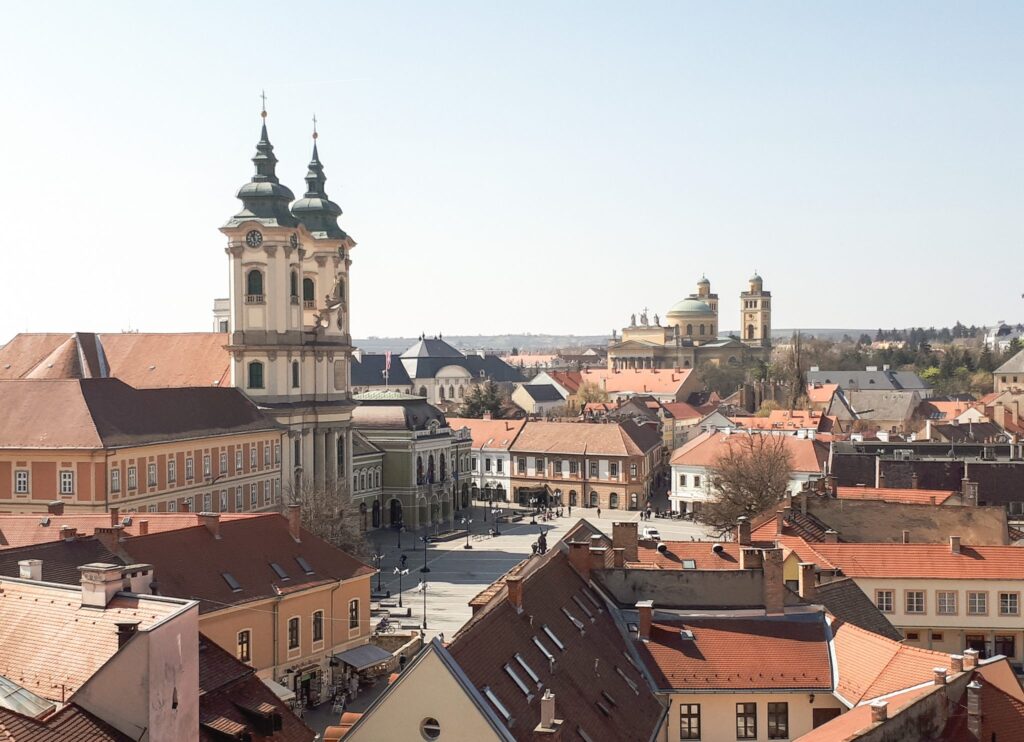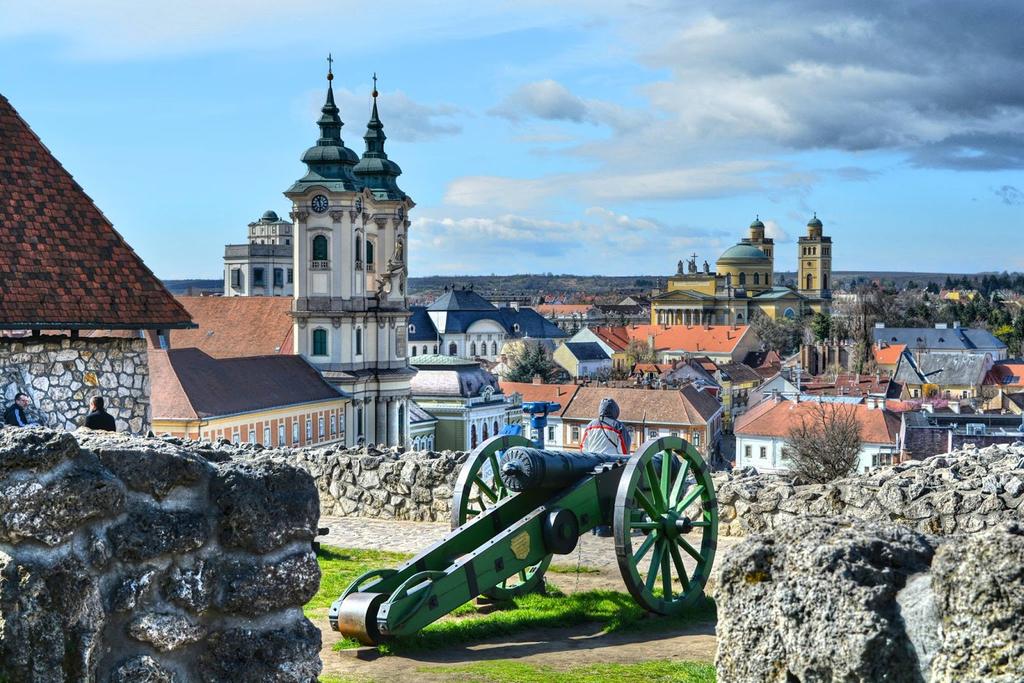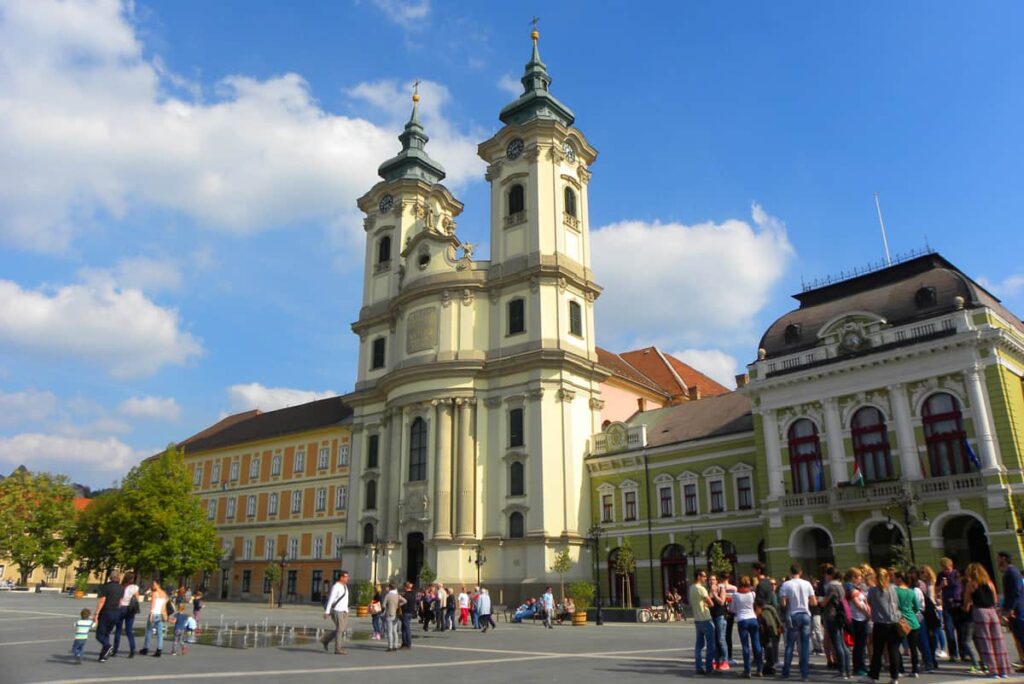Eger is best known for its castle, thermal baths, baroque buildings, the northernmost Ottoman minaret, dishes and red wines.
Eger is the county seat of Heves, and the second largest city in Northern Hungary (after Miskolc). Its population according to the census of 2011 makes it the 19th largest centre of population in Hungary. The town is located on the Eger Stream, on the hills of the Bükk Mountains.
Main sights
- The Castle of Eger, noted for its successful defence against the 1552 Ottoman invasion.
- The 17th-century Eger minaret. The northernmost Turkish minaret in Europe is 40 meters high and one of only three survivors in Hungary. It can be climbed for a good view of the town centre.
- The system of cellars near the cathedral, called the Város a város alatt (literally “Town under the town”).
- Dobó tér. The Baroque Minorite Church (1758–67), built to the designs of Kilian Ignaz Dientzenhofer of Prague with original ceiling frescoes by Márton Reindl, is the focal point of the town’s most imposing square, flanked by the Town Hall and the old priory buildings, part of which contain the Palóc Museum, showing the artefacts of a distinctive regional ethnic community. The square and several of the retail streets around it are pedestrianized.
- The Lyceum (Eszterházy College), designed by József Gerl and Jakab Fellner and built in 1765–85, is a splendid example of the restrained Zopf style. There are three remarkable 18th-century frescoed ceilings, of which only the one in the library is open to the public. Painted by the Viennese artist Johann Lukas Kracker in 1778, it depicts the Council of Trent of 1545–63, which launched the Counter-Reformation. Among the figures depicted are the Reformers Luther and Zwingli, whose “heretical” books are being struck by a bolt of lightning.
- The Turkish Bath, commissioned by Abdi Pasha the Albanian
- The Provost Minor’s Palace, 1758, is the finest Rococo building in the town. It also has a fine fresco by Kracker (“The Triumph of Virtue over Sin”), other 18th-century murals, and remarkable 18th-century wrought ironwork.
- The Archbishop’s Garden
- The Fazola gates, late Baroque wrought ironwork by Henrik Fazola
- The Archbishop’s Palace, a 15th-century Gothic palace
- The Egri Road Beatles Múzeum was established in Hotel Korona, in the heart of the historic town of Eger. Guests can get a glimpse of the life and career of the band and its members in the frames of a professional guided tour, which provides an experience supported by up-to-date technical solutions.
- Szépasszonyvölgy (“The Valley of the Beautiful Woman”). A valley on the southern edge of Eger which has numerous wine cellars, many with their own wine bar catering to tourists. A tram shuttles tourists to/from Dobó tér in the summer months.
Churches
Eger has 17 churches, but the notable ones include:
- The cathedral or basilica, built in 1831–37 to Classicist designs by József Hild, is imposing rather than attractive, but contains some remarkable painting and sculpture. Late morning organ recitals are held frequently.
- The Minorite Church, 18th-century Baroque church
- The Serbian Orthodox Church (Rác-templom) is in Zopf style (1784–86). The interior was commissioned from Viennese artists by the rich local Serbian community of that time. It is dominated by an iconostasis.
- St Bernard Cistercian Church, 18th-century Baroque church
Wine
Beside its historic sights and its thermal baths, Eger is famous for its wines. It produces both red and white wines of high quality. The famous and traditional varieties of the region are Egri Leányka, Egerszóláti Olaszrizling, Debrői Hárslevelű (whites), and Egri Bikavér (a red). More recently, Chardonnay and Pinot noir wines have appeared. The region’s wines are said to bear a resemblance to those of Burgundy. Although the quality of the wines deteriorated in the second half of the 20th century, especially the cuvees, Eger is slowly recovering its reputation as a wine region. The most important terroir of the Eger Wine Region is the Nagy-Eged Hill, which is a Grand Cru terroir, where premium Grand Superior wines are produced.
Tourism
The majority of visitors come for a single day (mostly from Slovakia), not staying overnight. Ukrainians and Russians frequent the Eger Castle, along with many Italians. Around the town, one may encounter many German-speaking travelers (Germans, Austrians, and Swiss) as well. However, the town is getting more popular for Turkish tourists, because of the common historical memories. Eger is mainly known for its castle, thermal baths (including an Olympic size swimming pool), historic buildings (including Eger minaret – the northernmost Turkish minaret) and, above all else, its famous Hungarian red wines.






